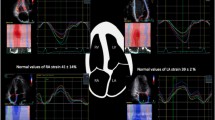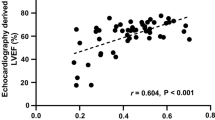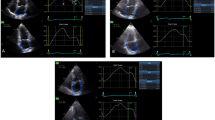Abstract
Myocardial strain measurement with two-dimensional speckle-tracking echocardiography (2D-STE) is of paramount importance in the early detection of subclinical left ventricular (LV) systolic dysfunction and the prediction of patient outcomes in various types of heart disease, especially when assessed with global longitudinal strain (GLS). The routine application of myocardial strain parameters requires the definition of normal values and an understanding of their reliabilities. One of the most important potential limitations to widespread clinical application of this technique is inter-vendor differences in normal strain values. Recent clinical reports indicate that the smallest differences were noted in GLS measurements among three orthogonal directions. Because the contribution of circumferential fibers to LV myocardial thickening is greater than that of longitudinal fibers, patients who have a reduced LV ejection fraction can have impaired global circumferential strain (GCS), which reflects more advanced intrinsic myocardial systolic dysfunction and is thus closely related to a poor prognosis. Since STE-derived strain analysis allows us to define the timing of the regional myocardial peak systolic deformation, it permits the assessment of LV mechanical dyssynchrony. The severity of LV mechanical dyssynchrony in the short axis plane, i.e., radial and/or circumferential strain imaging, is favorable for predicting the clinical response to cardiac resynchronization therapy. GLS in the right ventricular (RV) four-chamber view has recently been used as a surrogate for global RV function because longitudinal shortening is the major contributor to overall RV performance. Finally, 2D-STE can be used to quantify and characterize RV mechanical dyssynchrony in various diseases including acute pulmonary thromboembolism and chronic pulmonary hypertension.





Similar content being viewed by others
References
Yingchoncharoen T, Agarwal S, Popovic ZB, et al. Normal ranges of left ventricular strain: a meta-analysis. J Am Soc Echocardiogr. 2013;26:185–91.
Takigiku K, Takeuchi M, Izumi C, et al. Normal range of left ventricular 2-dimensional strain: Japanese Ultrasound Speckle Tracking of the Left Ventricle (JUSTICE) study. Circ J. 2012;76:2623–32.
Farsalinos KE, Daraban AM, Unlu S, et al. Head-to-head comparison of global longitudinal strain measurements among nine different vendors: the EACVI/ASE inter-vendor comparison study. J Am Soc Echocardiogr. 2015;28(1171–81):e1172.
Sun JP, Lee AP, Wu C, et al. Quantification of left ventricular regional myocardial function using two-dimensional speckle tracking echocardiography in healthy volunteers–a multi-center study. Int J Cardiol. 2013;167:495–501.
Zghal F, Bougteb H, Reant P, et al. Assessing global and regional left ventricular myocardial function in elderly patients using the bidimensional strain method. Echocardiography. 2011;28:978–82.
Cheng S, Larson MG, McCabe EL, et al. Age- and sex-based reference limits and clinical correlates of myocardial strain and synchrony: the Framingham Heart Study. Circ Cardiovasc Imaging. 2013;6:692–9.
Dalen H, Thorstensen A, et al. Segmental and global longitudinal strain and strain rate based on echocardiography of 1266 healthy individuals: the HUNT study in Norway. Eur J Echocardiogr. 2010;11:176–83.
Takamura T, Dohi K, Onishi K, et al. Left ventricular contraction-relaxation coupling in normal, hypertrophic, and failing myocardium quantified by speckle-tracking global strain and strain rate imaging. J Am Soc Echocardiogr. 2010;23:747–54.
Ishizu T, Seo Y, Kameda Y, et al. Left ventricular strain and transmural distribution of structural remodeling in hypertensive heart disease. Hypertension. 2014;63:500–6.
Enomoto M, Ishizu T, Seo Y, et al. Subendocardial systolic dysfunction in asymptomatic normotensive diabetic patients. Circ J. 2015;79:1749–55.
Kraigher-Krainer E, Shah AM, Gupta DK, et al. Impaired systolic function by strain imaging in heart failure with preserved ejection fraction. J Am Coll Cardiol. 2014;63:447–56.
Shah AM, Claggett B, Sweitzer NK, et al. Prognostic importance of impaired systolic function in heart failure with preserved ejection fraction and the impact of spironolactone. Circulation. 2015;132:402–14.
Yiu KH, Atsma DE, Delgado V, et al. Myocardial structural alteration and systolic dysfunction in preclinical hypertrophic cardiomyopathy mutation carriers. PLoS One. 2012;7:e36115.
Sun JP, Stewart WJ, Yang XS, et al. Differentiation of hypertrophic cardiomyopathy and cardiac amyloidosis from other causes of ventricular wall thickening by two-dimensional strain imaging echocardiography. Am J Cardiol. 2009;103:411–5.
Thavendiranathan P, Poulin F, Lim KD, et al. Use of myocardial strain imaging by echocardiography for the early detection of cardiotoxicity in patients during and after cancer chemotherapy: a systematic review. J Am Coll Cardiol. 2014;63(25 Pt A):2751–68.
Seidman AD, Fornier MN, Esteva FJ, et al. Weekly trastuzumab and paclitaxel therapy for metastatic breast cancer with analysis of efficacy by HER2 immunophenotype and gene amplification. J Clin Oncol. 2001;19:2587–95.
Galli E, Lancellotti P, Sengupta PP, et al. LV mechanics in mitral and aortic valve diseases: value of functional assessment beyond ejection fraction. JACC Cardiovasc Imaging. 2014;7:1151–66.
Yamashita E, Takeuchi M, Seo Y, et al. Prognostic value of paradoxical low-gradient severe aortic stenosis in Japan: Japanese Multicenter Aortic Stenosis Study, Retrospective (JUST-R) Registry. J Cardiol. 2015;65:360–8.
Sato K, Seo Y, Ishizu T, et al. Prognostic value of global longitudinal strain in paradoxical low-flow, low-gradient severe aortic stenosis with preserved ejection fraction. Circ J. 2014;78:2750–9.
Witkowski TG, Thomas JD, Debonnaire PJ, et al. Global longitudinal strain predicts left ventricular dysfunction after mitral valve repair. Eur Heart J Cardiovasc Imaging. 2013;14:69–76.
Cho GY, Marwick TH, Kim HS, et al. Global 2-dimensional strain as a new prognosticator in patients with heart failure. J Am Coll Cardiol. 2009;54:618–24.
Tanaka H, Matsumoto K, Sawa T, et al. Evaluation of global circumferential strain as prognostic marker after administration of beta-blockers for dilated cardiomyopathy. Int J Cardiovasc Imaging. 2014;30:1279–87.
Suffoletto MS, Dohi K, Cannesson M, et al. Novel speckle-tracking radial strain from routine black-and-white echocardiographic images to quantify dyssynchrony and predict response to cardiac resynchronization therapy. Circulation. 2006;113:960–8.
Maruo T, Seo Y, Yamada S, et al. The speckle tracking imaging for the assessment of cardiac resynchronization therapy (START) study. Circ J. 2015;79:613–22.
Chia EM, Hsieh CH, Boyd A, et al. Effects of age and gender on right ventricular systolic and diastolic function using two-dimensional speckle-tracking strain. J Am Soc Echocardiogr. 2014;27(1079–86):e1071.
Sugiura E, Dohi K, Onishi K, et al. Reversible right ventricular regional non-uniformity quantified by speckle-tracking strain imaging in patients with acute pulmonary thromboembolism. J Am Soc Echocardiogr. 2009;22:1353–9.
Ichikawa K, Dohi K, Sugiura E, et al. Ventricular function and dyssynchrony quantified by speckle-tracking echocardiography in patients with acute and chronic right ventricular pressure overload. J Am Soc Echocardiogr. 2013;26:483–92.
Fine NM, Chen L, Bastiansen PM, et al. Outcome prediction by quantitative right ventricular function assessment in 575 subjects evaluated for pulmonary hypertension. Circ Cardiovasc Imaging. 2013;6:711–21.
Norum IB, Ruddox V, Edvardsen T, et al. Diagnostic accuracy of left ventricular longitudinal function by speckle tracking echocardiography to predict significant coronary artery stenosis. A systematic review. BMC Med Imaging. 2015;15:25.
Okada K, Yamada S, Iwano H, et al. Myocardial shortening in 3 orthogonal directions and its transmural variation in patients with nonobstructive hypertrophic cardiomyopathy. Circ J. 2015;79:2471–9.
Dohi K, Onishi K, Gorcsan J 3rd, et al. Role of radial strain and displacement imaging to quantify wall motion dyssynchrony in patients with left ventricular mechanical dyssynchrony and chronic right ventricular pressure overload. Am J Cardiol. 2008;101:1206–12.
Author information
Authors and Affiliations
Corresponding author
Ethics declarations
Conflict of interest
K.D. received lecture fees of equal to or more than 500,000 yen from Otsuka Pharma Inc. in 2015. M.I. received lecture fees of more than 500,000 yen from Daiichi Sankyo Co. Ltd. and Mochida Pharmaceutical Co., Ltd. in 2015. M.I. received a single-year research grant for the Department of Cardiology and Nephrology, Mie University Graduate School of Medicine, of equal to or more than 2 million yen, from Bristol-Myer K.K., AstraZeneca K.K., MSD K.K. and BIOTRONIK JAPAN. INC. in 2015. No relevant conflicts of interest related to the article were disclosed by the authors.
Rights and permissions
About this article
Cite this article
Dohi, K., Sugiura, E. & Ito, M. Utility of strain-echocardiography in current clinical practice. J Echocardiogr 14, 61–70 (2016). https://doi.org/10.1007/s12574-016-0282-8
Received:
Revised:
Accepted:
Published:
Issue Date:
DOI: https://doi.org/10.1007/s12574-016-0282-8




